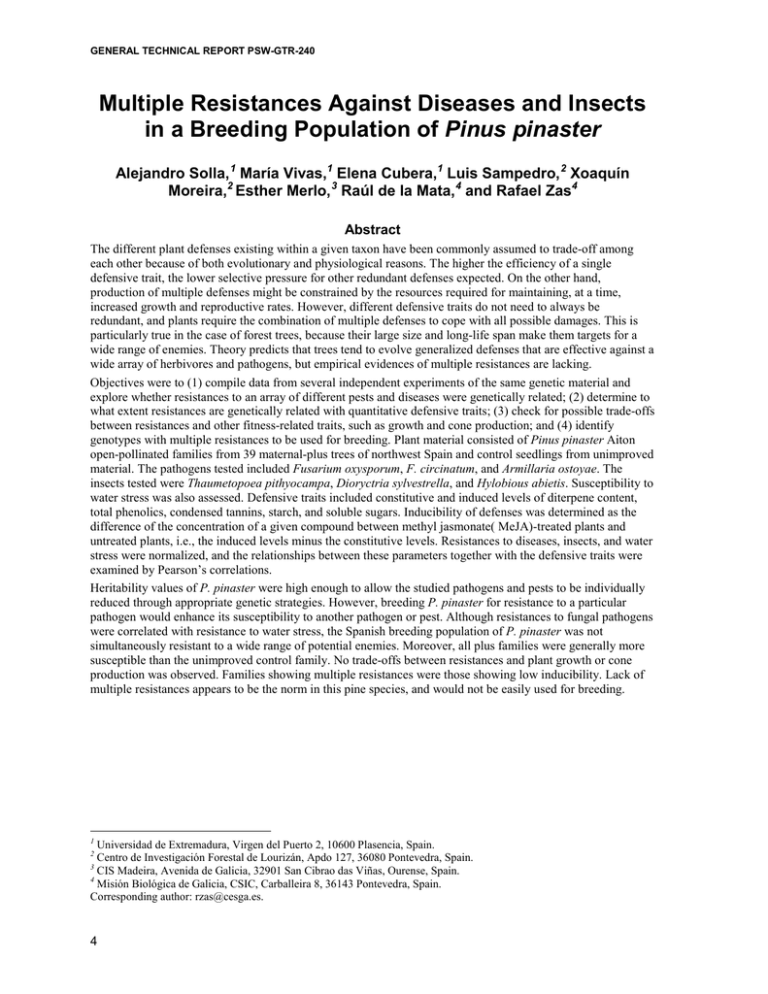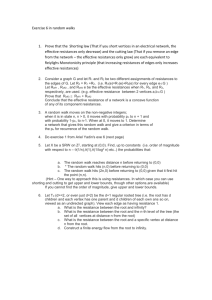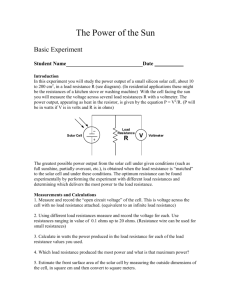Multiple Resistances Against Diseases and Insects Pinus pinaster Alejandro Solla,
advertisement

GENERAL TECHNICAL REPORT PSW-GTR-240 Multiple Resistances Against Diseases and Insects in a Breeding Population of Pinus pinaster Alejandro Solla, 1 María Vivas,1 Elena Cubera,1 Luis Sampedro, 2 Xoaquín Moreira,2 Esther Merlo, 3 Raúl de la Mata, 4 and Rafael Zas4 Abstract The different plant defenses existing within a given taxon have been commonly assumed to trade-off among each other because of both evolutionary and physiological reasons. The higher the efficiency of a single defensive trait, the lower selective pressure for other redundant defenses expected. On the other hand, production of multiple defenses might be constrained by the resources required for maintaining, at a time, increased growth and reproductive rates. However, different defensive traits do not need to always be redundant, and plants require the combination of multiple defenses to cope with all possible damages. This is particularly true in the case of forest trees, because their large size and long-life span make them targets for a wide range of enemies. Theory predicts that trees tend to evolve generalized defenses that are effective against a wide array of herbivores and pathogens, but empirical evidences of multiple resistances are lacking. Objectives were to (1) compile data from several independent experiments of the same genetic material and explore whether resistances to an array of different pests and diseases were genetically related; (2) determine to what extent resistances are genetically related with quantitative defensive traits; (3) check for possible trade-offs between resistances and other fitness-related traits, such as growth and cone production; and (4) identify genotypes with multiple resistances to be used for breeding. Plant material consisted of Pinus pinaster Aiton open-pollinated families from 39 maternal-plus trees of northwest Spain and control seedlings from unimproved material. The pathogens tested included Fusarium oxysporum, F. circinatum, and Armillaria ostoyae. The insects tested were Thaumetopoea pithyocampa, Dioryctria sylvestrella, and Hylobious abietis. Susceptibility to water stress was also assessed. Defensive traits included constitutive and induced levels of diterpene content, total phenolics, condensed tannins, starch, and soluble sugars. Inducibility of defenses was determined as the difference of the concentration of a given compound between methyl jasmonate( MeJA)-treated plants and untreated plants, i.e., the induced levels minus the constitutive levels. Resistances to diseases, insects, and water stress were normalized, and the relationships between these parameters together with the defensive traits were examined by Pearson’s correlations. Heritability values of P. pinaster were high enough to allow the studied pathogens and pests to be individually reduced through appropriate genetic strategies. However, breeding P. pinaster for resistance to a particular pathogen would enhance its susceptibility to another pathogen or pest. Although resistances to fungal pathogens were correlated with resistance to water stress, the Spanish breeding population of P. pinaster was not simultaneously resistant to a wide range of potential enemies. Moreover, all plus families were generally more susceptible than the unimproved control family. No trade-offs between resistances and plant growth or cone production was observed. Families showing multiple resistances were those showing low inducibility. Lack of multiple resistances appears to be the norm in this pine species, and would not be easily used for breeding. 1 Universidad de Extremadura, Virgen del Puerto 2, 10600 Plasencia, Spain. Centro de Investigación Forestal de Lourizán, Apdo 127, 36080 Pontevedra, Spain. 3 CIS Madeira, Avenida de Galicia, 32901 San Cibrao das Viñas, Ourense, Spain. 4 Misión Biológica de Galicia, CSIC, Carballeira 8, 36143 Pontevedra, Spain. Corresponding author: rzas@cesga.es. 2 4







